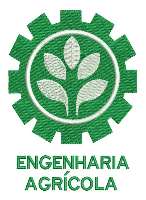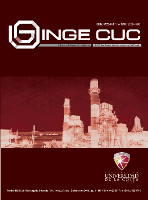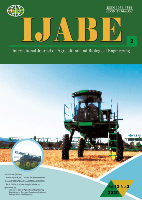
Journal of Agricultural Machinery
Scope & Guideline
Driving Progress in Agriculture with Open Access Knowledge
Introduction
Aims and Scopes
- Agricultural Machinery Design and Optimization:
Research in this area encompasses the design, construction, and performance optimization of various agricultural machines and tools, including harvesters, sprayers, and drying systems. Emphasis is placed on enhancing operational efficiency and reducing energy consumption. - Sustainable Agricultural Practices:
The journal promotes studies that integrate sustainability into agricultural practices, such as the use of renewable energy sources, waste management, and eco-friendly technologies to improve agricultural productivity while minimizing environmental impact. - Mechanization and Automation in Agriculture:
This focus area includes the development and application of automated systems and robotics in agriculture. It covers topics like machine vision, robotic harvesting, and automation techniques that improve efficiency and reduce labor costs. - Energy Efficiency and Environmental Impact Assessments:
Research that evaluates the energy consumption and environmental impacts of agricultural practices and machinery is a core scope. This includes studies on bioenergy, exergy analysis, and life cycle assessments. - Sensor Technologies and Data Analysis in Agriculture:
The journal includes studies on the integration of sensor technologies, remote sensing, and data analytics in agricultural practices. This aspect highlights the role of precision agriculture in optimizing inputs and improving crop yields.
Trending and Emerging
- Nanotechnology in Agriculture:
There is an increasing interest in the application of nanotechnology, such as the use of nanoparticles in materials for agricultural machinery and crop protection, which enhances efficiency and sustainability. - Data-Driven Approaches and Machine Learning:
Emerging themes include the use of machine learning and artificial intelligence for predictive analytics in agriculture, such as optimizing harvests and resource management through advanced data analysis. - Cold Plasma Technology Applications:
Research on cold plasma technology is gaining traction, particularly for its applications in pest control, food preservation, and seed treatment, indicating a trend towards innovative non-chemical methods in agriculture. - Integration of Renewable Energy Systems:
There is a growing emphasis on integrating renewable energy sources, such as solar and wind energy, into agricultural machinery and processes, reflecting a broader commitment to sustainability in agricultural practices. - Advanced Sensor Technologies and IoT in Agriculture:
The use of IoT (Internet of Things) and advanced sensor technologies is trending, with an emphasis on real-time monitoring and automation in agricultural settings, enhancing precision agriculture.
Declining or Waning
- Traditional Tillage Practices:
Research related to conventional tillage methods has diminished as the focus shifts towards conservation tillage and no-till practices that promote soil health and reduce erosion. - Manual Harvesting Techniques:
With the rise of mechanization and automation, studies centered on manual harvesting techniques are becoming less prevalent. The emphasis is now on developing more efficient mechanized harvesting solutions. - Basic Mechanical Engineering Principles:
While foundational mechanical engineering remains important, there is a noticeable decline in papers that focus solely on traditional mechanical engineering principles without their application in advanced agricultural technologies.
Similar Journals

German Journal of Agricultural Economics
Empowering Research in Agricultural and Biological SciencesThe German Journal of Agricultural Economics, published by the esteemed DEUTSCHER FACHVERLAG GMBH, serves as a pivotal platform for the dissemination of research in the fields of Agricultural and Biological Sciences as well as Economics and Econometrics. Situated in Germany, this journal, with ISSN 0515-6866 and E-ISSN 2191-4028, has established a notable presence, reflected in its 2023 category quartiles—ranking Q2 in Agricultural and Biological Sciences (miscellaneous) and Q3 in Economics and Econometrics. With a converged publication timeline from 2011 to 2024, it aims to foster dialogue and research innovation related to agricultural economics, with an emphasis on contemporary challenges and advancements in the sector. The journal seeks to cater to a diverse audience, including researchers, professionals, and students, by providing access to high-quality, peer-reviewed articles that contribute to the ongoing discourse in these critical areas of study. Whether you are looking to keep abreast of the latest findings or seeking publishing opportunities, the German Journal of Agricultural Economics is an essential resource for anyone engaged in agricultural and economic research.

Engenharia Agricola
Pioneering research in agricultural engineering excellence.Engenharia Agricola, published by the SOC BRASIL ENGENHARIA AGRICOLA, is a crucial open-access journal that has been at the forefront of agricultural engineering research since its inception in 1981. With an E-ISSN of 1809-4430 and an ISSN of 0100-6916, this journal stands out in the field by providing a platform for disseminating innovative studies and advancements in agricultural practices and technologies. Based in Brazil, the journal emphasizes global perspectives in agricultural and biological sciences, currently positioned in the Q3 quartile of its category, as recognized in the 2023 Scopus Ranks, where it ranks 97 out of 193 publications. Researchers, professionals, and students can access a plethora of high-quality articles that contribute to sustainable agronomy, agricultural mechanics, and resource efficiency across various environments, with open access since 2004, ensuring that critical knowledge is readily available to all stakeholders in the field.

NJAS-Impact in Agricultural and Life Sciences
Innovating solutions for sustainable agriculture and environmental health.NJAS-Impact in Agricultural and Life Sciences is a pivotal open-access journal, published by Taylor & Francis Ltd, focusing on the interdisciplinary nexus between agricultural practices and life sciences. Anchored in the United Kingdom, this journal aims to provide a comprehensive platform for the dissemination of innovative research that addresses critical challenges in environmental sustainability, agricultural productivity, and biological advancements. With its inaugural issue dated from 2023 to 2024, NJAS prominently features the latest empirical studies, reviews, and theoretical contributions that enrich existing knowledge and provoke thought among researchers and practitioners alike. Although currently ranking within the lower percentiles across various Scopus categories, the journal aspires to establish itself as a significant contributor to the dialogue on agricultural and environmental sciences. As scholars in these fields seek to bridge the gaps in understanding, NJAS invites submission from diverse perspectives, underscoring the importance of collaborative knowledge-building in addressing the complexities of our changing global landscape.

Revista Ciencia Agronomica
Transforming research into real-world agricultural solutions.Revista Ciencia Agronomica is a leading open access journal published by the Universidade Federal do Ceará, Departamento de Geociências, dedicated to advancing the field of agricultural sciences. Established in 2008, the journal has emerged as a significant platform for the dissemination of original research and innovative advancements in areas including agronomy, horticulture, and soil science, with a dedicated convergence of years extending to 2025. With an impactful presence in academic circles—ranking in Q3 for Agronomy and Crop Science and Soil Science and Q2 for Horticulture in 2023—this journal provides vital insights for researchers and practitioners alike. Although specific HIndex metrics are currently unavailable, the journal's Scopus rankings attest to its relevance, placing it in the 52nd, 44th, and 43rd percentiles across multiple pertinent categories. Since transitioning to an open access model in 2010, Revista Ciencia Agronomica has committed to maximizing the reach and impact of its published work, thereby ensuring valuable contributions to global agricultural knowledge.

INGE CUC
Fostering Collaboration in Engineering ExcellenceINGE CUC is an esteemed open-access journal published by UNIV COSTA, focusing on advancements and innovations in engineering and applied sciences. With its ISSN 0122-6517 and E-ISSN 2382-4700, the journal has committed to providing a platform for the dissemination of high-quality research since 2010. Operating out of Barranquilla, Colombia, INGE CUC serves as a vital resource for researchers, professionals, and students alike, offering insightful articles that bridge theoretical concepts with practical applications. Though certain metrics such as HIndex may currently be under development, the journal's open-access model ensures widespread access to its contents, fostering a dynamic exchange of knowledge within the engineering community. As INGE CUC continues to evolve, it remains dedicated to promoting innovation and collaboration in the field, establishing itself as a prominent voice among peer-reviewed journals in engineering.

Transactions of the ASABE
Bridging research and practice for a sustainable tomorrow.Transactions of the ASABE is a premier journal published by the American Society of Agricultural and Biological Engineers, specializing in innovative research and practical applications in the fields of agricultural and biological engineering. With an ISSN of 2151-0032 and E-ISSN 2151-0040, this journal has established a vital niche in disseminating high-quality scholarly content that addresses the complex challenges faced in agriculture and biological systems. The journal operates under an open access model, facilitating broad dissemination of research findings to a global audience. This commitment to accessibility is reflected in its coverage of diverse topics, including agriculture, soil science, food science, and environmental engineering. Although the journal's coverage in Scopus was discontinued in 2021, it once ranked among the top in its categories, indicating its significant contribution to advancing knowledge in these essential fields. Researchers, practitioners, and students are encouraged to engage with the Transactions of the ASABE to stay abreast of developments and foster collaboration in promoting sustainable engineering solutions.

JOURNAL OF AGRICULTURAL AND RESOURCE ECONOMICS
Empowering research for sustainable agricultural practices.Journal of Agricultural and Resource Economics is a pivotal platform in the realm of agricultural and resource economics, published by the Western Agricultural Economics Association. Since its inception, the journal has embraced an Open Access model, fostering widespread dissemination of research findings to benefit both scholars and practitioners in the field. The journal operates within an impressive global ranking framework, resting in Q2 across several pertinent categories including Agronomy and Crop Science, Animal Science and Zoology, and Economics and Econometrics. With its ISSN 1068-5502 and E-ISSN 2327-8285, it has garnered attention for its rigorous academic standards and impactful contributions to the discourse on resource management and agricultural practices. Researchers, professionals, and students alike will find the journal's ongoing commitment to advancing knowledge invaluable, with publications that span from 1996 to 2024 capturing evolving trends and insights in the sector.

Journal of Tekirdag Agriculture Faculty-Tekirdag Ziraat Fakultesi Dergisi
Advancing agricultural innovation and environmental solutions.The Journal of Tekirdag Agriculture Faculty-Tekirdag Ziraat Fakultesi Dergisi, published by UNIV NAMIK KEMAL, represents a significant platform dedicated to the dissemination of research in the fields of agricultural and biological sciences. With an ISSN of 1302-7050 and E-ISSN 2146-5894, this journal aims to advance knowledge and innovation within its scope, which encompasses a diverse array of agricultural topics and environmental pollution. Notably, it has achieved a Q3 category ranking in Agricultural and Biological Sciences and a Q4 category ranking in Pollution for 2023, reflecting its growing influence in the academic community. Operating from Turkey, the journal publishes articles that seek to address contemporary challenges in agriculture and environmental science, thus fostering collaborations among researchers, professionals, and students worldwide. Researchers can benefit from the journal’s focus on applied sciences, providing insights and solutions pertinent to real-world issues. Engage with cutting-edge studies and contribute to this evolving field by exploring the transformative research featured within.

International Journal of Agricultural and Biological Engineering
Driving progress in engineering solutions for agriculture.Welcome to the International Journal of Agricultural and Biological Engineering, a premier open-access publication dedicated to advancing the fields of agricultural and biological engineering. Established and published by the Chinese Academy of Agricultural Engineering, this journal has been at the forefront of academic discourse since its inception in 2008. With an impact factor that reflects the journal's esteemed reputation, it ranks impressively in the Q2 category for both Agricultural and Biological Sciences and Engineering, showcasing its influence in these vital fields. The journal's commitment to innovation is underscored by its open-access model, ensuring that vital research is accessible to a global audience. Covering a diverse scope of topics relevant to the integration of engineering principles in agricultural practices, this journal is an essential resource for researchers, professionals, and students alike, providing insights that drive advancements and sustainable practices within the industry. With a dedicated editorial board and a rigorous peer-review process, the International Journal of Agricultural and Biological Engineering is poised to contribute significantly to the growth and development of knowledge in agricultural and biological systems.

Smart Agricultural Technology
Pioneering Interdisciplinary Research in Smart AgricultureSmart Agricultural Technology, an esteemed journal published by ELSEVIER, stands at the forefront of agricultural innovation, with its focus on the intersection of cutting-edge technology and sustainable farming practices. Established in 2021, this Open Access journal is committed to disseminating pivotal research findings in the fields of Agricultural and Biological Sciences, Artificial Intelligence, and Computer Science, ensuring that crucial developments are accessible to all stakeholders. With a notable impact factor denoted by its impressive Q1 and Q2 categorizations, Smart Agricultural Technology ranks among the top journals in its fields, boasting a percentile standing of 76th in Agricultural and Biological Sciences and 68th in Computer Science advancements. Operating out of the Netherlands, the journal offers a dynamic platform for researchers, professionals, and students to explore, share, and drive forward the agenda of smart agriculture through vital interdisciplinary collaboration and knowledge dissemination. Featured in Scopus, it promises not only rigor and excellence but also a vibrant forum for groundbreaking ideas and practices that can transform the agricultural landscape.